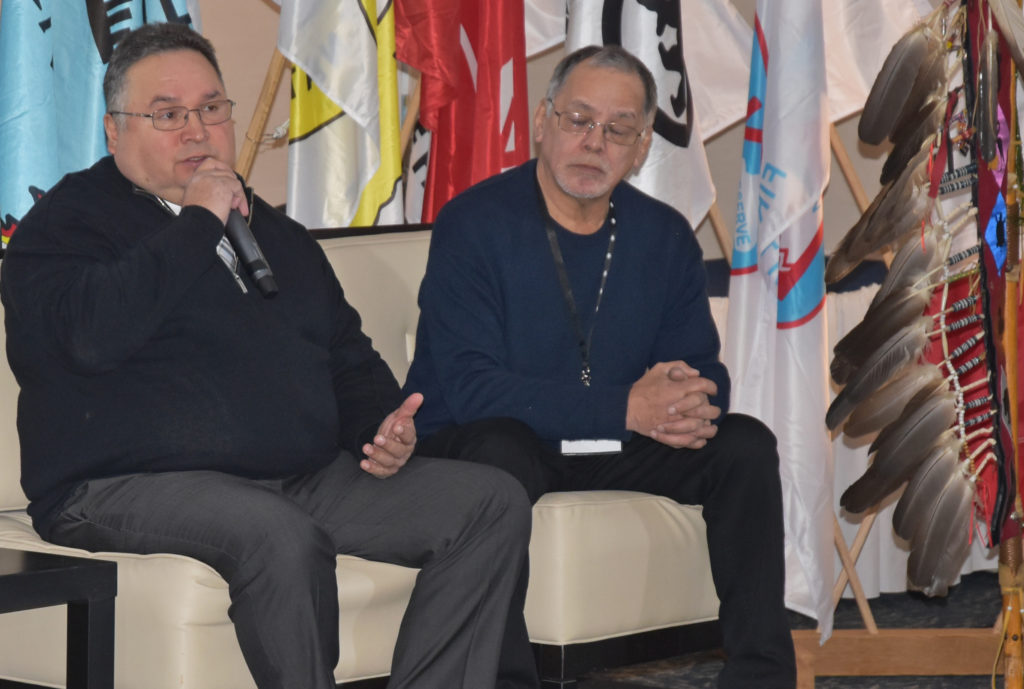Consultation on aerial spraying STILL not working

By Kelly Anne Smith
NORTH BAY – The right to fish, hunt, gather and harvest within the Robinson Huron Treaty territory has been infringed upon with aerial spraying of Northern Ontario forests.
So say critics of the practice of using chemistry, sometimes including glyphosate, to design a living forest. The Elders from the group Traditional Ecological Knowledge or TEK have been active lobbying the government to protest the threat to their way of life.
Lake Huron Regional Grand Chief Paul Eskakogan voiced his concern at the 2018 Anishinabek News Lands and Resources Forum held on the traditional land of Nipissing First Nation. The Best Western 3-day conference took place across the street from Lake Nipissing.
During the Leadership session, Regional Grand Chief Eskakogan called for change in Ontario’s forest management practice and manuals and in the consultation process.
Eskakogan talked of First Nations needing more time for analyzing what, where and when the spraying is to take place. He stresses that at least a year is needed when considering getting Elders and knowledge keepers into the forest to see what is at stake for the area.
Eskakogan points out the government’s time frame for consultation is always last minute. “It’s about our process too. We want to go out and examine those areas, then they’ll (Sustainable Forest Licenses or SFLs) come back and say, ‘We’ve done that already.’” Eskakogan says, “No, you haven’t. Not for what we look for. We need a year to do an adequate job and somebody has to pay for that. We also have to have a third-party expert review on their work.”
He wants a seat at the board table for Sustainable Forest Licenses (SFLs) granted by the Ministry of Natural Resources and Forestry. “They have boards in our area. We should be on the board making decisions on the management of our forests.”
A process change is needed says the Sagamok Anishnawbek citizen. “We just saw the maps where they are going to spray. But what they do, is put a whole lot of areas that they would like to spray. Then sometime around June we’ll hear from them on the areas they are actually going to spray. So that doesn’t leave us a lot of time to get out there and have a look at the area.”
We have our Elders and technicians go out and see how the berry crop might be. Right now, there really isn’t a lot of snow. But you never know what is going to happen between now and June. If we get a lot of rain and good warm weather, we’ll probably have a good berry crop. “
Eshkakogan says forests can be managed without toxic chemistry. “We want them to move toward more manual tending of Jack Pine and Spruce stands. Instead of using chemicals, let’s use brush saws to remove the competing vegetation.”
So far, 21 Robinson Huron Treaty Area Chiefs support a moratorium on spraying. As previously reported, Elder Ray Owl says, “The province wants to see all First Nations on board the ban.” http://anishinabeknews.ca/2017/06/01/aerial-spraying-has-to-stop-says-elder-ray-owl/
There is data on herbicides on the Ministry of Agriculture, Food and Rural Affairs. http://www.omafra.gov.on.ca/english/crops/facts/00-061.htm
A 1991 forest management guide is available here: https://www.ontario.ca/document/forest-management-aerial-spraying


